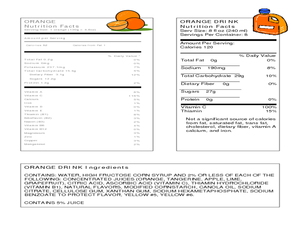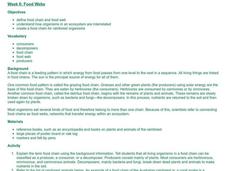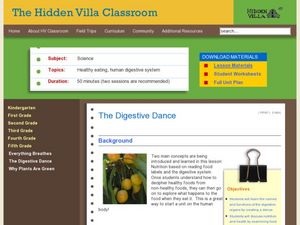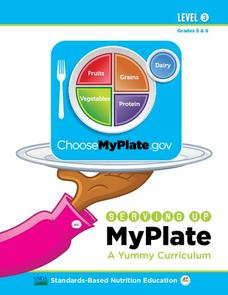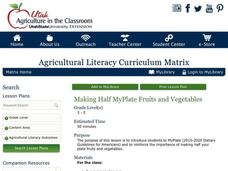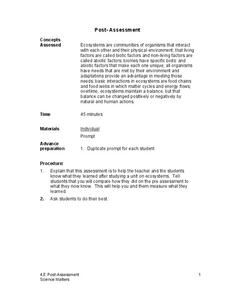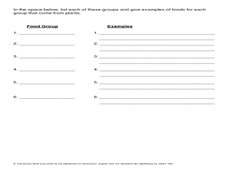Curated OER
Identifying Food Nutrients
Students pretend they are a food-quality tester. They develop a kit to test food for sugars, starches, proteins and lipids. They answer questions to complete the lesson plan.
Curated OER
Reading Food Labels
Fourth graders examine the food labels on two similar items that are very different nutritionally such as a can of regular soda and a can of diet soda. Next they, sort through food labels to determine healthy and unhealthy foods by...
Curated OER
The Food Pyramid
Students determine that humans need food to function properly. In this nutrition lesson plan, students discuss the food categories used in the food pyramid by charting the foods eaten in one day.
Curated OER
Food Label Reference Guide
In this food label worksheet, students read the label and dialogue bubbles to learn how to interpret a food label. Worksheet is for reference only, no associated tasks.
Curated OER
Healthy Food is Good Food!
Students examine the difference between whole foods and junk foods. In this food lesson, students learn the definitions of whole food and junk food. They find the difference in tastes and textures of different foods by performing taste...
Curated OER
Foreign Cuisine: International Foods
Students describe factors that influence one's food choices, explain how food choices reflect one's culture and ethnic background, identify ways that family members and friends may affect one's food decisions and preferences, and explain...
Curated OER
Rainforest Food Chain
Learners investigate a rainforest food chain. In this ecology lesson, students are shown pictures of plants and list what animals might eat the plants. Learners continue to think of what other animals might eat those animals. Students...
Curated OER
Food for Thought
Fifth graders explore the brain and what is needs. In this biology lesson plan, 5th graders will work on a series of activities that will allow them to learn about the brain, its parts, and the best foods to eat for their brain.
Curated OER
Soil in My Food Web
Fourth graders understand the importance of soil to the food web. In this food web lesson, 4th graders create various food webs beginning with soil using yarn and name cards. Students write about the importance of soil to one...
Curated OER
Food Energy and Nutrients
In this food energy and nutrients activity, students fill in the blank and complete a chart with information about food energy and essential nutrients needed for the body. Using the Nelson text, students complete a chart about different...
Curated OER
Where do Plants Get their Food?
In this where do plants get their food worksheet, students design an experiment that will disprove the idea that plants obtain their food from soil. Students will set up their experiment and design a data table that will record data over...
Curated OER
Food Webs
Young scholars research rainforest animals and use that information to make a flow chart to show the order in which energy is transferred through several organisms. They label the producers, consumers, and decomposers in their chart.
Curated OER
Grains, Fats, and Sugars in Healthy Proportions - Skill
Students investigate dietary guidelines and the food guide pyramid. They prepare various versions of pasta and muffins, and compare the taste, calories, fat, and cholesterol content.
Curated OER
The Root Show
Students investigate plant roots. In this plant lesson, students discover the function and structure of plant roots. Students plant a plant in a milk carton with a clear section cut out in order to observe the roots of the plant.
Curated OER
The Digestive Dance
Students read food labels to compare healthy verses non healthy food and then use diagrams to create a poster of the digestive system. In this food lesson plan, students move the food down the digestive track along the digestive system.
American Museum of Natural History
What's This? Feeding
Some species have pretty creative methods for catching food. Young scientists learn about some interesting ways organisms get the nutrients they need by navigating an online interactive lesson that would be suitable for a remote learning...
US Department of Agriculture
Serving Up My Plate
Within three nutrition-themed, inquiry-based learning opportunities, pupils take notice of their eating habits; delve deep into the five food groups, gain experience in planning meals, participate in a taste test, and explore ads...
Agriculture in the Classroom
Making Half MyPlate Fruits and Vegetables
Establish healthy eating habits with a lesson focused around MyPlate's food recommendations and the importance of eating fruits and vegetables. Through class discussion and worksheet completion, scholars discuss the best choices of foods...
Science Matters
Post-Assessment
Twenty questions make up an assessment designed to test super scientists' knowledge of ecosystems. Scholars answer multiple-choice and short-answer questions about organisms, food chains, energy flow, and more.
Curated OER
Dietary Guidelines/Food Pyramid
Students study the recommended Dietary Guidelines for Americans and the Food Guide Pyramid. They discuss the foods they eat, watch a video about the Food Pyramid and examine actual foods portioned out into recommended serving sizes.
Curated OER
Nutrients for Plants and People: Gardening for Good Health
In this food pyramid worksheet, students read about each food group in the food pyramid, and then write examples for each one. Students write 6 groups and 6 examples.
Curated OER
THE FOODS WE EAT
Students discuss the five food groups and the seven basic nutrients. They decorate Food We Eat booklet pages with pictures of foods found on background, rubber stamp and animation tools in KidPix. (Booklet has a page for each food group.)
Curated OER
Food Chains Are Not A Necklace!
Second graders examine how food chains interact with different plants and animals. They practice using new vocabulary. They also discover the role of pesticides in the environment.
Curated OER
How Food Moves Through the Body
In this food and digestion worksheet, students read a short article the digestive system and choose the multiple choice answer for 11 questions. Students also put the organs that food moves through in the correct sequential order.




